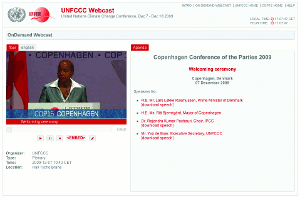Case Study: The Political Climate of Live Streaming
From December 7-19, 2009, the eyes of the world were focused on Copenhagen, including eyes directed at computer screens.
 The Danish capital was the venue for the largest world climate change conference-in fact, the largest international political conference of any kind-to date. Never before has a conference taken place in which approximately 140 heads of state participated at the same time. That aside, the annual climate conference of the U.N. Framework Convention on Climate Change (UNFCCC) is a challenge for all those participating. In principle, these conferences are working meetings during which participants negotiate, discuss, and reach decisions over a period of 2 weeks. In addition to the representatives of the 192 participating nations and NGOs (nongovernmental organisations) such as Greenpeace, participants include scientists, media representatives, and other political figures such as Al Gore and Arnold Schwarzenegger.
The Danish capital was the venue for the largest world climate change conference-in fact, the largest international political conference of any kind-to date. Never before has a conference taken place in which approximately 140 heads of state participated at the same time. That aside, the annual climate conference of the U.N. Framework Convention on Climate Change (UNFCCC) is a challenge for all those participating. In principle, these conferences are working meetings during which participants negotiate, discuss, and reach decisions over a period of 2 weeks. In addition to the representatives of the 192 participating nations and NGOs (nongovernmental organisations) such as Greenpeace, participants include scientists, media representatives, and other political figures such as Al Gore and Arnold Schwarzenegger.
This has also had an impact on the webcast. So far, more than a million users have viewed the webcast and 290,000 watched live.
By the Numbers
The on-site webcast production included the following:
• 2 weeks live and on-demand webcast production, mainly bilingual
• 7 different live channels with direct viewing
• 297 sessions webcasted live and posted immediately as on-demand videos
• 66 additional side events made available as on-demand videos
The meta-fusion team (meta-fusion is the general webcast service provider for UNFCCC) comprised 16 operators on-site. The team was supported by a three-man editorial team from the UNFCCC. However, the meta-fusion team was not the Danish government's only responsibility as event organiser; the Bella Centre in Copenhagen accommodates 15,000 visitors, and temporary offices and workstations had to be equipped with printers, telephones, fax machines, connections to internal file servers, and, of course, internet access. In
addition to the offices, numerous soundproof meeting and presentation rooms, simultaneous interpreters (the U.N. works in eight official languages), press conference rooms, television studios, "stand-ups" for live conferences, and a large printing facility for all official documents were required.
Because the political processes involved cannot be planned or predicted, this climate change conference demands a large degree
of flexibility of the decision makers and participating service providers. Negotiations may be terminated after just 5 minutes or may last for 15 hours without a break. Press conferences are announced or cancelled at short notice. In addition to overall flexibility, all services must remain available 24 hours a day.